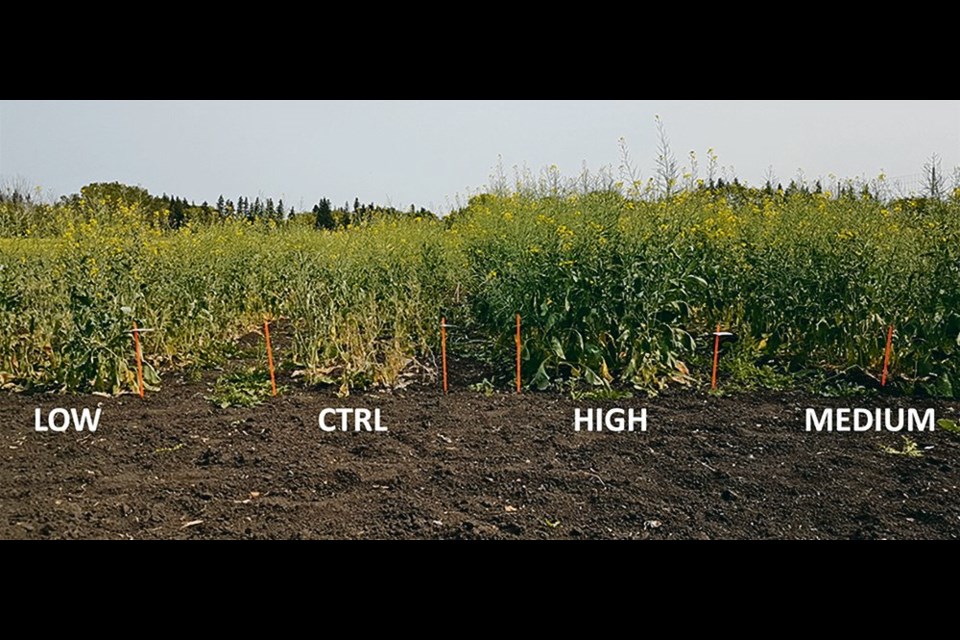WESTERN PRODUCER — Can lime reduce clubroot in canola if environmental conditions and timing are right?
Yes, say researchers.
“Now we know, when all things are right, lime can significantly reduce the disease severity and have quite impressive results,” said Stephen Strelkov, a University of Alberta plant pathologist who co-authored the study.
U of A researchers tested two lime products and concluded it is an option against clubroot, in addition to using canola varieties bred to resist the disease.
“Although genetic resistance is the most economical and effective way to control clubroot disease in canola, breeders will not be able to keep up with emerging and shifting pathotypes across the country,” said Nicole Fox, who evaluated lime products as part of her master’s degree at the U of A. The findings are published in the Canadian Journal of Plant Pathology.
“It is important to supplement resistant cultivars with other practices to ensure the longevity of the most effective tool, (that) being genetics.”
Using lime is nothing new for those who grow vegetable brassicas such as broccoli and cabbage. Market gardeners mix it into the soil to increase pH and neutralize highly acidic soil, which makes conditions less favourable for clubroot development.
“Our idea was to try to see if we could adopt and compare to see if we could apply some of those same principles to the management of clubroot on canola, which is obviously quite a different crop,” said Strelkov.
The two-year study, in 2017-18, involved field and greenhouse trials using different lime formulations and monitored pathogen proliferation in root tissues after various treatments.
Hydrated or powdered lime was shown to be more effective than granulated limestone in greenhouse and replicated field plot experiments.
“Hydrated lime had a significant effect basically at all spore concentrations and it really reduced the disease a lot, so it was overall more effective than the limestone,” said Strelkov, noting results in crop health and yield were obvious.
Greenhouse and field canola crops grown in unlimed soils were stunted and poor yielding, with heavy disease development in their roots.
“The ones that received the lime, particularly the high to medium rate of lime, looked much healthier, much reduced symptom development, increased growth,” he said.
“Under the greenhouse conditions the disease almost completely disappeared, so definitely a big difference.”
Field and greenhouse trials were done at the Crop Diversification Centre North complex near Edmonton, which is part of the Alberta agriculture ministry.
After the soil’s starting pH was determined, lime application rates were chosen to increase pH in 0.5 increments. At the two highest application rates of hydrated lime (11.4 T ha-1 and 12.7 T ha-1), clubroot disease severity was reduced by 35 to 91 percent, which almost eliminated any visible signs of galls on the roots. Above-ground plant biomass increased by 58 to 116 percent.
The same hydrated lime application rates tested in the field were used in a greenhouse study. Hydrated lime eliminated visible symptoms of clubroot disease at all tested rates.
The time between application and seeding can have a big impact on the efficacy of the lime treatment.
“We found in 2017 we got very strong results,” Strelkov said.
“That year we applied the lime and then we seeded it one week later, and there was rainfall in between. That was kind of an ideal scenario.”
In the following year, plots had to be reseeded after cutworm damage. It created a four-week gap between lime application and seeding, with minimal precipitation.
“In 2018 our results were not nearly as promising so it shows that liming can be effective, but in some ways it’s more finicky than something like genetic resistance. When it’s working, it’s working right.”
Future studies will test the effectiveness of lime after year one, but Strelkov said researchers already know the impact on soil can be transient, particularly with hydrated lime.
“You increase it and then it starts to decline again,” he said.
“You’ll need to hit it again with lime probably a couple of years later to bring it back to the target pH.
“It would be something that the grower would have to continue to monitor to see where the pH is at, but certainly the cost relative to the other limestone formulation is a drawback. It’s effective but certainly more expensive.”
The price of hydrated lime during the study was $320 per tonne compared to more commonly used agricultural limestone at $54 per tonne. Researchers are evaluating less expensive formulations.
In the meantime, Fox advised farmers to use the more expensive lime product only in a field’s biggest problem areas.
“Anything less than a pH of five, it’s already a very acidic environment for any crops to really thrive in…. If it’s not that acidic, then you don’t have a super big problem yet. Maybe you have time to play around with the agricultural limestone that takes a little bit more time to work,” she said.
“The Canola Council (of Canada) talks about grassing your entrances. Perhaps liming your entrances is another option as well.”
Strelkov said growing susceptible varieties of canola in fields with known clubroot is never recommended. However, lime could be another tool to improve sustainability and help with clubroot resistance.
Lime could also be used to maintain yields in situations where there is no effective resistance against new clubroot strains.
“I think genetic resistance is going to remain the backbone of clubroot management, but tools like liming may become important to augment that and to make it a more sustainable management and a more robust system overall,” said Strelkov.
Added Fox: “It could be a game changer if we were to lose the genetic ability to control this pathogen. As of right now, I still think genetics are way more sustainable.”




